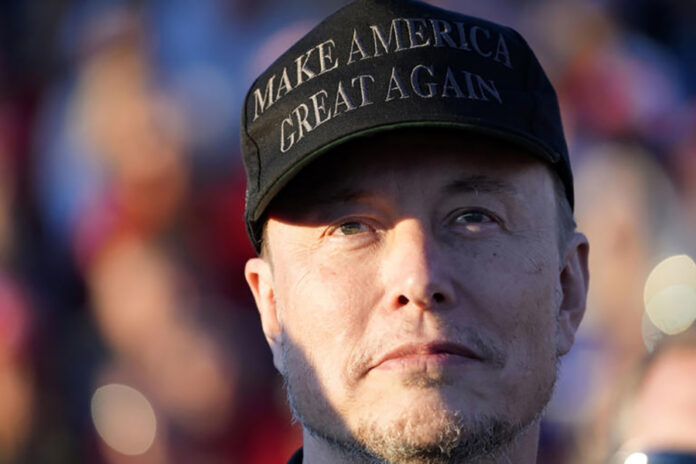
WASHINGTON— Elon Musk’s super PAC spent around $200 million to help elect Donald Trump, according to a person familiar with the group’s spending, funding an effort that set a new standard for how billionaires can influence elections.
The billionaire Tesla and SpaceX CEO provided the vast majority of the money to America PAC, which focused on low-propensity and first-time voters, according to the person, who was not authorized to disclose the figure publicly and spoke on condition of anonymity.
America PAC’s work was aided by a March ruling from the Federal Election Commission that paved the way for super PACs to coordinate their canvassing efforts with campaigns, allowing the Trump campaign to rely on the near-unlimited money of the nation’s most high-profile billionaire to boost turnout in deep-red parts of the country. That allowed the campaign to spend the money they saved on everything from national ad campaigns to targeted outreach toward demographics Democrats once dominated.
The plan worked for both sides. Trump saw key turnout surges in battleground states, and at the end of the campaign the president-elect credited Musk’s role in the race. “We have a new star,” Trump said at his election night party in Florida. “A star is born — Elon!”
“The FEC ruling cleared the way for us to gain more benefit from soft money enterprises that were going out and doing this work anyway,” said James Blair, the Trump campaign’s political director.
Blair worked as the main bridge between the Trump operation and groups like America PAC — a far cry from the early days of super PACs having to decide their strategy without communicating officially with the campaigns they were backing.
“By conserving hard dollars, we were able to go wider and deeper on paid voter contact and advertising programs,” Blair said. That, he added, included broad ad campaigns aimed at a national audience, as well as — critically — more targeted campaigns looking to boost turnout among Black and Latino men, two areas where Trump saw sweeping gains in 2024.
It wasn’t just Musk’s money that helped Trump. The billionaire businessman became one of Trump’s highest-profile surrogates in the final months of the campaign, often joining the former president onstage. His support gave Trump a clear opening into the universe of younger men who look up to Musk.
Trump also benefited from Musk’s ownership of X, the social media platform formerly known as Twitter, and the company’s work to end many of the rules that hampered Trump before he was kicked off in 2021. Like many conservatives, Musk is a fierce critic of social media efforts to counter disinformation, arguing that those efforts amount to pro-government censorship.
Musk is now expected to play a key role in a second Trump administration. The president-elect has said he will place Musk, whose rocket company works with the Defense Department and intelligence agencies, in charge of a new government efficiency commission.
A challenge to conventional wisdom
The work between the Trump campaign and America PAC has potentially longer-lasting implications.
It could yield a wholesale shift in the way presidential races are run, overturning longstanding conventional wisdom about campaigns lacking total control of their field program, the impact billionaires can have in politics and the effectiveness of paid canvassing operations.
One reason for skepticism is that this model had failed spectacularly for past campaigns, most notably during Florida Gov. Ron DeSantis’ run in the 2024 Republican presidential primary against Trump.
DeSantis, more than any other candidate in the primary, relied on an outside group to buttress his campaign. The group, Never Back Down, was beset by internal issues, and despite spending $130 million to tout the Florida governor, it was swamped by Trump and his campaign operation in Iowa.
One of the most persistent issues, however, was the blurring of lines around what is legally permissible between the campaign and the outside group, an issue that worried some within the governor’s official campaign.
That, however, was before the FEC ruling, meaning Trump and Musk’s group were operating in an entirely different universe than a few months earlier during the primary.
The ruling “allowed a much more direct line of communication regarding canvassing,” Blair said. “That is a real difference and a critical difference.”
Musk’s outside group was founded in May, but it wasn’t until Musk endorsed Trump in July, after the former president survived an assassination attempt, that the group more clearly began its turnout work. A week later, in an interview with a conservative podcaster, Musk acknowledged the new committee and a host of top Republican operatives with ties to DeSantis joined the effort.
The group ran ads that warned if people sat out the election, “Kamala and the crazies will win.” The highest-profile part of America PAC’s work was a $1 million-a-day voter sweepstakes that landed the group in court before a judge said it was allowed to continue. The sweepstakes and subsequent court case drew considerable attention, but much of America PAC’s work happened under the radar.
Door knocking was arguably America PAC’s most impactful work, with Trump experiencing boosts in turnout in key rural areas in battleground states. The work, however, was not without controversy.
A report from The Guardian found America PAC’s efforts were rife with paid canvassers faking their work and saying they had knocked on doors that they had not visited. Multiple reports from Wired alleged that some of those paid canvassers worked in poor conditions, including riding in the back of a rented U-Haul van and facing threats to meet unfeasible quotas. Canvassers were fired after the Wired report, leading to a lawsuit against America PAC.
A spokesperson for America PAC declined to comment on the record for this story.
Musk, meanwhile, indicated in an election night conversation on X that his PAC will stay involved in politics, “preparing for the midterms and any intermediate elections, as well as looking at elections at the District Attorney and sort of judicial levels.”






